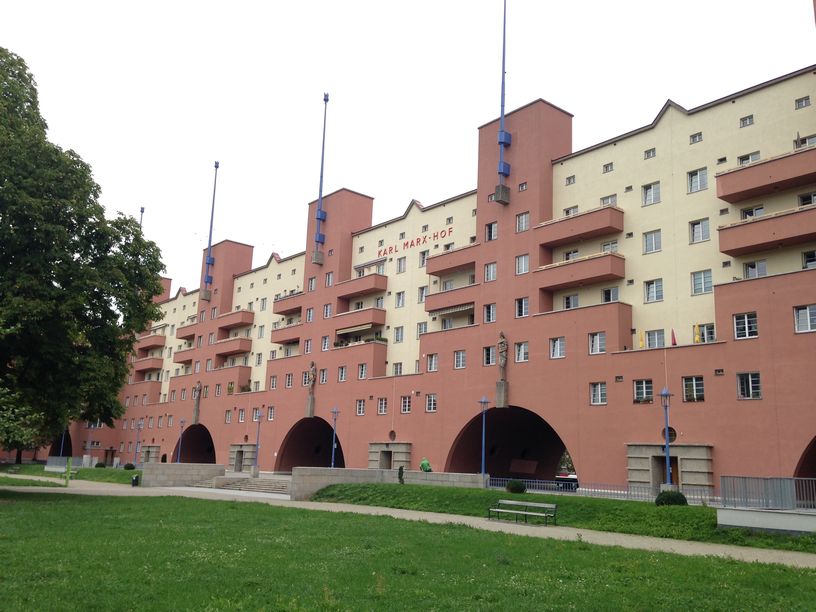
Cities around the world, from Vancouver to Toronto, New York to London, and Berlin and many others have experienced housing crises over the last decade. While the local details may differ, the root cause is the same – rampant profiteering from homes.
Housing Movements in Cities Around the World
In Los Angeles, where California laws prohibited rent controls and the homeless population has climbed to nearly 60,000, 2018 saw a wave of high-profile rent strikes that culminated with the largest in the city’s history: two hundred families in three apartment buildings striking against unlivable conditions and sharp rent increases. In 2019 the California state legislature changed course and limited increases on some rentals to 5% plus inflation.
In 2018, Seattle produced a movement of tenants and workers led by Socialist Alternative’s councillor Kshama Sawant, who pushed the council’s approval of the Amazon Tax, tax on a handful of the city’s largest corporations that would have raised $47 million a year to build housing. Only one month later the rest of the city council capitulated to pressure from Amazon and repealed the tax. Average rents for a one-bedroom apartment in Seattle have more than doubled in eight years to $2,700 CAD. Now there is a powerful and growing campaign for rent controls in the city.
In Berlin, where rents have more than doubled in ten years, profit-dreamers blame the crisis on immigration and government regulation. Renters are demanding instead that the big landlords, beneficiaries of mass selloffs beginning fifteen years ago of public housing built by the former East German state, be expropriated by the city and returned to public ownership. Deutsche Wohnen, a corporate firm that owns over 100,000 apartments in Berlin, is naturally opposed to this proposal. In an attempted compromise, the city has recently passed a five-year rent freeze.
In Dublin, which saw homelessness increase 95% for adults and 227% for children between 2015 and 2018, and where a mortgage crisis looms heavily, 10,000 people marched in May 2019 under the banner “Raise the Roof,” which pushed the Dail (Irish parliament) into passing an opposition motion that will dramatically increase funding for social housing while restricting the ability of landlords and banks to evict tenants into homelessness.
Tenants in New York gained momentum with the election of several high-profile progressive candidates in 2018, many of whom endorsed and campaigned on the idea of universal rent control. On June 14, this movement pushed through new legislation that strengthens tenants’ protections and closes several loopholes that landlords had used to remove units from rent stabilization.
The rental problem stems from decades of cuts to funding and building public housing and speculation in both the housing market and, increasingly, homes for rent. Waves of footloose capital have moved into rental properties, seeking profits from human misery. Large corporations are buying up significant amounts of rental stock.
One example is the giant corporation Blackstone that has bought rental properties around the world, including in the US (with Federal government help), Spain, Ireland, Canada and Sweden. These include formerly publicly-owned homes. The common strategy is to push up rents, cut maintenance provision, ruthlessly evict tenants and make a pile of cash. It bought 1,800 social housing units from the city of Madrid, paying €202 million (about $300 million CAD) in 2013 in a dodgy deal arranged by the son of disgraced former Spanish prime minister Aznar. The homes are now valued at €660 million – a 227% return in just five years! Rents have been hiked by 49%, with those who cannot afford it evicted. In 2018 it invested $5.6 million to successfully defeat Proposition 10 that would have allowed stronger rent control in California.
Since landlords and developers are unable to voluntarily curb their behaviour, the solution is to legislate and tax them. Rent control, corporate taxes, expropriation, and building social housing would constrain the market and provide some semblance of stability for renters.
The Origins of Canada’s Housing Crisis
Canada is an increasingly urban country, with the rate of urbanization outstripping the population growth rate. Over 80% of its population live in cities, with 40% living in the largest four: Toronto, Montreal, Vancouver, and Calgary. As people have moved into its largest cities, housing has become increasingly important to the Canadian economy. This sector employs workers in a range of different industries from finance and accounting, to law, skilled trades, construction and engineering. In 2017, real estate and related industries accounted for over 20% of Canada’s GDP. However, the housing market is not equally distributed across the country. While more homes are being built now than ever before, the housing industry is dominated by the construction of massive glass towers in Toronto, Vancouver and, increasingly, Montreal. Many units are pre-sold condos, reflecting the market conditions of a few years ago. Today, the pace of sales in both Vancouver and Toronto has begun to slow down.
Housing growth has created a vast expansion of mortgage debt, well over $1.5 trillion, the fastest growing segment of which is reverse mortgages, essentially borrowing against the value of your house. This has produced homeowners making record-breaking mortgage payments and living in constant fear of the next interest rate hike, and a national housing market ripe for recession. Rent in these cities of course remains chronically unaffordable. Over-committed homeowners, high rents, and increased urbanization are, however, only the cold sweat of a fever. We must look deeper to find the law that governs them.
From 1962 to 1973 Canada’s GDP grew on average at 5.4%, just above the OECD (a club of 36 of the world’s richest nations) average of 5.3%. Since 2010, however, Canada’s GDP growth has slowed to an average of 2.3%, which now leads the OECD. This sharp drop in economic growth for Canada and other developed countries could be the subject of several books. One characteristic factor is the large decline in manufacturing as a share of Canada’s GDP, falling from 30% in the 1950s to just 10% today, although total production of goods has grown. More goods are being produced in Canada, but the rate of profit per good produced is lower. Similar trends can be seen in agriculture, one of the traditional pillars of the Canadian economy. Investing in manufacturing and agriculture, which once shaped and supported urban and rural life respectively, is not as profitable as it was in decades past.
While some capitalists may be content to hoard wealth in such circumstances, as the Panama Papers revealed, money is not capital when it is trapped in the bank. Especially after the recession of 2008, central banks poured trillions of dollars into the economy to stimulate growth. However, most of this money was not invested in production, instead it flowed into speculation around the world. Housing, both to purchase and to rent, was a major destination of this hot money. This has fuelled a global speculative bubble. Capital might have good reason for raising up such prisms, labyrinths, clusters of cubes and planes and Cyclopean buildings, and we can read into their odd angles a mathematical significance that seems to offer vague clues regarding their purpose.
A home is likely to be the only commodity most people ever own that will actually appreciate in value. It is this capacity for property value to increase that drives the production of housing in the private market. Unfortunately, this is also the reason that home ownership is out of reach for so many working people around the world. As manufacturing capital becomes less important in the larger urban centres, profits are sought in housing speculation. Neighbourhoods with lower property values are made to appear fashionable, justifying rent increases and displacing lower-income tenants. Since a property with higher rent is worth more, property values begin to rise. The property value next door to an expensive property is likely to also rise, justifying higher rents there too and bringing in more investment. Soon construction begins on luxury condo townhouses and towers and in this way gentrification spreads across the city from one neighbourhood to the next. All this displacement and investment, reshaping the city, is based on the guess that the next person will pay more for it. Once prices rise so high that no one can afford to buy into this speculative market it becomes a game only between the ultra-rich, swapping large piles of money and tiny condos back and forth. The real estate market begins to contract, and investment dries up, as it has in Canada for the fifth consecutive quarter, historically a sign of looming recession.
As the city becomes more expensive those who can’t make the increased rent are forced to move to the suburbs or become homeless and the market for rental housing that people can actually afford tightens. Vancouver now officially has 2,223 people street homeless (an underestimation) and a 0% vacancy rate for apartments that rent for less than $750 a month. As real-estate capital comes to dominate the physical landscape of the city it also dominates the political landscape, pushing zoning and regulations that reinforce the market. Developers and their political and academic friends claim that the low supply of rental stock is the cause of the housing crisis. This view claims that only the market can provide homes and therefore, as developers will only build housing for profit, the solution is to remove any restrictions on construction or on rents. This is the logic of the federal Liberal’s National Housing Strategy which, among other things, will see the federal government spend 19% less as a share of GDP on assisted housing over the next ten years in favour of rent subsidies. In Vancouver this takes the shape of incentive programs like “Rental 100” that offer large tax incentives to developers who commit to “purpose-built rental housing.” Eventually, it is claimed, as developers are encouraged to build more and more high-end rental housing, supply will line up with demand and the prices ought to come back into line. But a wise man once said that what only “ought” to be, without actually being, has no truth. Housing that is too expensive to house the people who need it, is not in truth housing but is instead only a financial asset. The reality of these pro-market policies has been increasingly higher rents for increasingly smaller apartments, as though the ratio between the two were governed by some unreal logic out of space and time.
Economic crisis is always echoed by an ideological crisis, though the two do not always arrive at the same moment. In Vancouver, the election of Jean Swanson reflects both the housing crisis rooted in the economy, and the ideological crisis of Vision Vancouver that dominated municipal politics over the past decade. Similarly, the demands for expropriation in Berlin and universal rent control in New York reflect the economic circumstances of renters in these cities and the rejection of the market ideology of those who dream of profit. Swanson campaigned on a four-year rent freeze and a progressive property tax to fund social housing, both policies that directly challenge the idea that the crisis can be solved through the market alone. What remains to be seen is whether a strong enough movement will mobilize around Swanson’s proposals, as they have begun to in New York and Berlin, to make these proposals into reality.
Winning the Housing We Need
One city that stands in contrast to all the others mentioned earlier is Vienna, where 60% of housing is in public hands. During the 1920s and until 1934, when it was brought down by a fascist coup d’etat, Vienna had a radical left-wing government that levied high taxes against the rich and used the money to fund massive high-quality social housing projects. Following World War II, Vienna began to build social housing again at a rate of 5,000 units per year, climbing to 10,000 per year during the 1960s and 1970s. Unsurprisingly, housing in Vienna is much less expensive than in most other cities with the average tenant spending only 27% of their income on rent. These housing programs were initially enacted by the Social Democratic Workers’ Party which dominated Vienna politics in the years following World War I but they were not won by the party, they were won by the movements of workers and urban masses whose living conditions had deteriorated drastically. These formed the electoral base of the party and the pressure they were able to exert on it won the housing reforms that shape Vienna to this day. In Vancouver, Toronto, New York, Berlin, Los Angeles and more, winning our struggle for affordable housing will require building powerful movements of workers.
Socialist Alternative campaigns for taxes on the rich and developers to raise the funds for cities to build social housing with unionized workers. We campaign for high-quality, well-maintained housing, run by tenants’ democracy. The glass cities that have been imposed on us and that have shaped and constrained our lives, are there as a monument for the rich who regard housing as a commodity, to increase their wealth. Solutions that rely on market incentives cannot fix the problem. Only by limiting the scope of the market and ultimately removing housing from its grip altogether, by building for need rather than profit, can we provide long-term, high-quality stable housing for all. Strong city housing policies would increase leverage in demanding the provincial and federal governments contribute to building social housing. A strong house-building program, along with rent controls and tenant protection laws, would start to turn housing from a commodity for the rich to homes for people.


